Media Delivery API
The Media Delivery API is a new way to get media streams from eSDK. The API decouples audio decoding and playback from fetching files. This makes it possible to add support for new file formats to already released versions of the eSDK by using decoders provided by the application.
The API functions are documented in the file spotify_embedded_media.h. This document gives an overview of different use cases with the API.
Terms
| Term | Description |
|---|---|
| Application | The partner code that uses the eSDK. |
| Playback | The process of a media device taking raw or uncompressed samples and playing them through a speaker, headphones or equivalent. |
| Track | A single media entity. Note that one track could consist of more than one stream. |
| Playing Track | The currently playing track |
| Upcoming Track | The track that will be streamed and played next, regardless of if it's the next, previous, or otherwise indexed track in the current context |
| Next Track | The next track in the current context |
| Previous Track | The previous track in the current context |
| Stream | Byte stream for the media. Similar to the downloading of a file. |
| Stream id | A unique identifier which is used to differentiate media streams. |
| Stream start | Beginning of media stream. The point where the decoder should be initialized. Compare with opening a media file. |
| Stream end | End of media stream. When the track is playing, stream end will inform the application that there are no more data to be expected. The decoder can then be freed after all the stream are decoded and pcm samples output to the audio driver. Compare with closing a media file. |
| Streaming | Delivering data to the application. |
| Flush | Action where all queued encoded or decoded media data is cleared. |
Audio Streaming Overview
This is an overview of the flow of data and the role of each party, eSDK and the application.
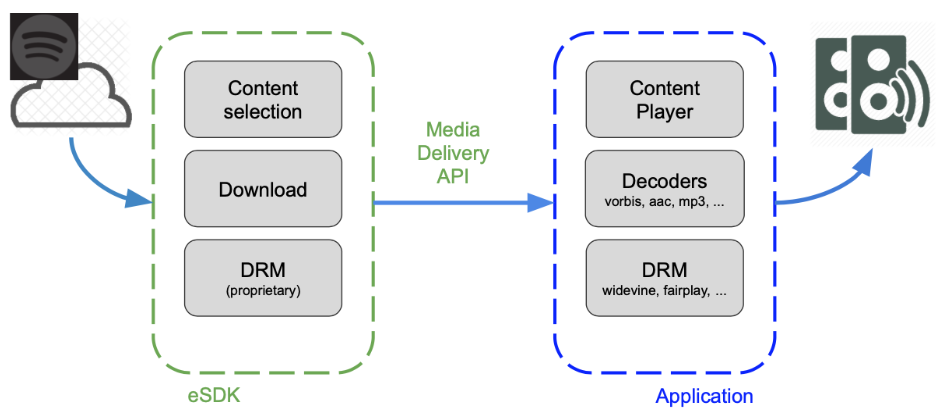
Note: Implementing DRM in the application will be supported for only a subset of formats.
Invariants
StreamStartis always paired with the correspondingStreamEnd(i.e. samestream_id)- There can be at most one stream in progress at any time, being delivered to the Application (i.e. only one StreamStart without the corresponding
StreamEnd) - When a Stream is delivered, eSDK will proceed with the next stream to prefetch the next track: Two streams then exist, the first one that is currently playing and the second one that is prefetching.
API
Media Delivery API uses notifications, callbacks, events and a set of auxiliary functions.
Notifications
The application must call the notification functions for the eSDK to be able to track the current state of the application:
- SpNotifyStreamPlaybackStarted
- SpNotifyStreamPlaybackContinued
- SpNotifyStreamPlaybackFinishedNaturally
- SpNotifyTrackLength
- SpNotifyTrackError
For more information please refer to the API reference documentation for spotify_embedded_media.h and the sequence diagrams under Media Delivery API use cases.
Callbacks
The application must register a set of callbacks using SpRegisterStreamCallbacks. The callbacks are described in the following C structure:
_14struct SpStreamCallbacks {_14 /* Start of stream callback */_14 SpCallbackStreamStart on_start;_14 /* Data stream callback */_14 SpCallbackStreamData on_data;_14 /* End of stream callback */_14 SpCallbackStreamEnd on_end;_14 /* Current playback position callback */_14 SpCallbackStreamGetPosition on_get_position;_14 /* Seek to position callback */_14 SpCallbackStreamSeekToPosition on_seek_position;_14 /* Flush callback */_14 SpCallbackStreamFlush on_flush;_14};
For more information please refer to the API reference documentation in spotify_embedded_media.h.
Events
In addition to other eSDK notifications this Media Delivery API uses two notifications that the application should handle through the eSDK notification callback: kSpPlaybackNotifyPlay and kSpPlaybackNotifyPause. It's important that the application buffers delivered data, and plays/pauses it based on those notifications. When the application buffer is full, the new samples delivered by eSDK should be rejected until space in the buffer is available again.
Media Delivery API use cases
Here is a description of the API usage in different use cases such as skipping and seeking. The following sequence diagrams document how eSDK and the application are supposed to function.
Playing a track
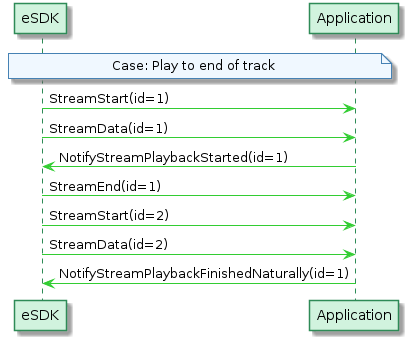
Track 1 is the track that is being played. Track 2 is the upcoming track that is being prefetched. The application buffer will have to keep track of two positions: the playback position (the samples being played) and the delivery position (the samples being buffered).
At a given moment, the buffer might contain data from different streams. The application is not required to keep track of the position where a stream ends or begins. The following diagram illustrate the state of the buffer at a given moment:
Case: playing stream which is being delivered

Case: prefetching upcoming stream while playing first stream
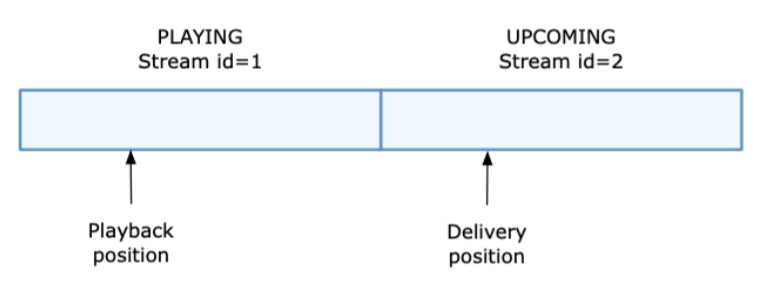
Skipping
Skip while the playing track is being delivered
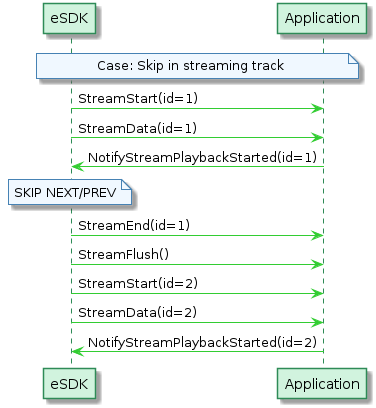
Skipping while a track is being streamed will trigger StreamEnd followed by
StreamFlush. After this the StreamStart is triggered for the upcoming
track.
Skip when upcoming track was, or is being delivered
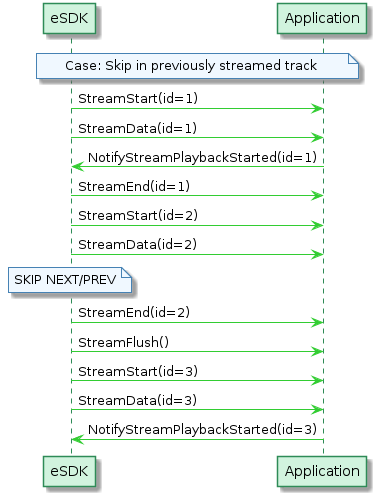
- Skipping to the next or the previous track will get rid of all buffered data, both played and not yet played samples.
- The next stream delivery will always have a new ID.
- Stream id 1 is the playing track
- Stream id 2 is the next/previous track
- Stream id 3 is the same track as Track 2 (the next/previous track)
Seeking
Streams which are seekable have a known size in the beginning of the stream.
That is, StreamStart callback will have non-zero stream_size_bytes value.
Start playing a track with non-zero starting position

- Usually tracks start from the beginning (position zero), but in some cases, a track can start from a non-zero starting position. For example:
- When starting a podcast from a previously stored resume point.
- When pushing a playing state to the application using Spotify Connect.
- If a track should start playing at a position greater than 0,
StreamStartwill be followed byStreamSeekToPositionbeforeStreamDatais called for the stream. - The application needs to call SpSetDownloadPosition to set the byte offset from where eSDK will start streaming data.
- Once the Application has the bytes that it needs to play from the intended offset, it must call SpNotifySeekComplete to let the eSDK know it's ready to start playback. Please refer to the Seeking and Download Position section.
Seek in streaming track

-
Seeking in a track which is still streaming triggers the
StreamFlushcallback, after which the application should call the SetDownloadPosition function with the new offset. This function may be called multiple times to get the corrent seek position. When the correct stream position has been obtained, a call to SpNotifySeekComplete will inform eSDK that the seek is done. -
The stream delivery will resume from the seek position using the same ID as before.
Seek when upcoming track has been, or is being delivered
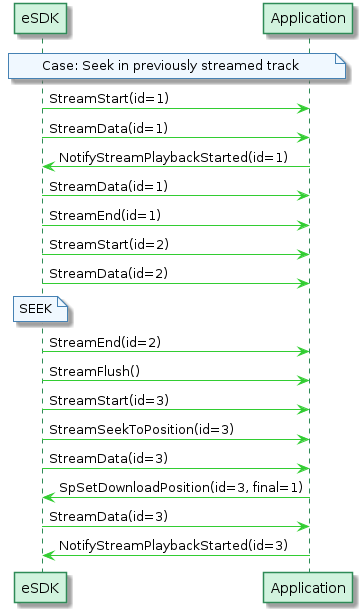
- If the playing track has been fully streamed and the upcoming track streaming has started, all data from the upcoming track will be discarded and re-streamed to the application eventually.
- In this case
id=3is the same track asid=1, but since the stream has already ended, there will be a new stream.
Bitrate changes
Note: This section is only applicable for eSDK build profiles that enable automatic bitrate changes between tracks or in the middle of tracks, or if the application intentionally calls SpPlaybackSetBitrate while streaming.
Change bitrate middle of playing track which is being delivered
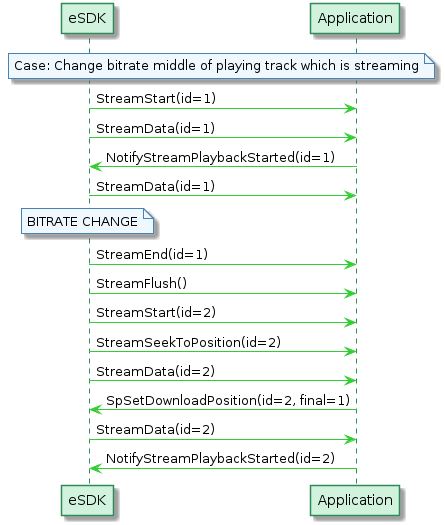
- Playing a track when the bitrate changes will result in audio data being dropped.
- The stream delivery will restart from the last played position and will use a new ID.
Change bitrate in the middle of a playing track when upcoming track is delivering
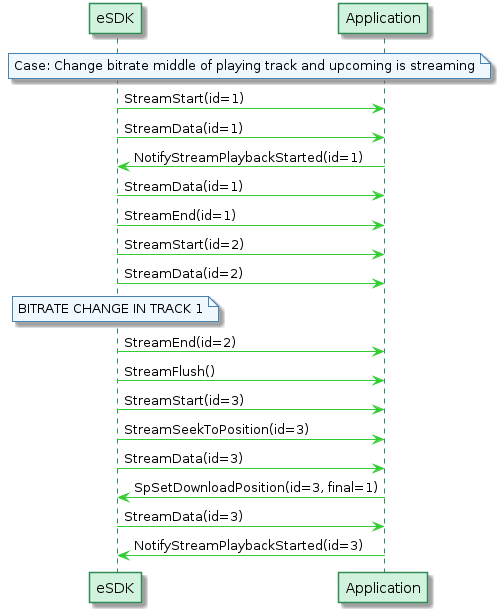
Playing a fully buffered track during a bitrate change will result in all audio data being dropped. The stream delivery will restart from the last played position and will use a new ID.
Change bitrate for the upcoming track which is already delivering
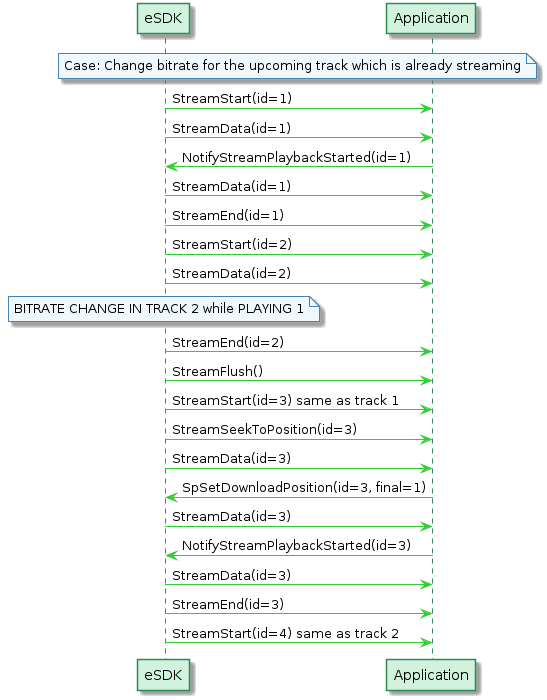
- Changing bitrate in a track where data is already available will result in audio data being dropped.
- The stream delivery will provide a new ID.
Errors
For eSDK to be able to handle errors properly, any playback and/or decoding errors need to be reported back from the application to the eSDK. Error reporting is done through the function SpNotifyTrackError.
Application cannot the initialize decoder

- If the application cannot decode a track (because of unsupported format etc.), it needs to call SpNotifyTrackError to inform eSDK.
- Track 1 is interrupted and marked as failed
- Playback advances to track 2
Playing track which is streaming has a decoding or playback error

- Track 1 is interrupted and marked as failed
- Playback advances to track 2
Playing and already streamed track has a decoding or playback error

- Track 1 is interrupted and marked as failed
- Playback advances to the next track and streaming starts again for track 2 with new Stream ID 3
Upcoming streaming track has decoding error
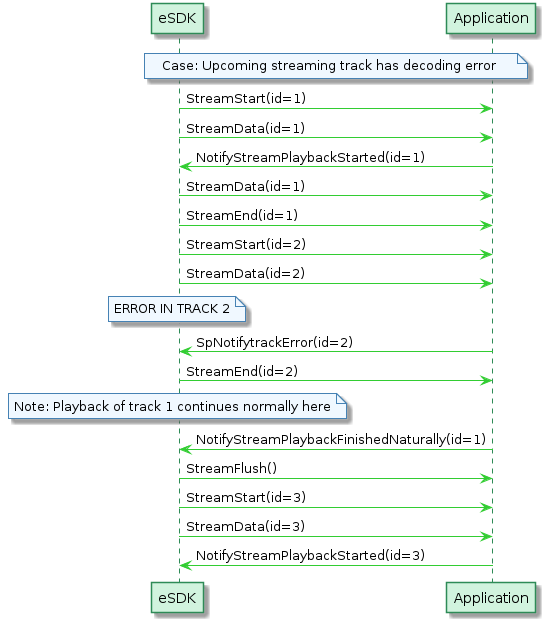
- Track 1 is played fully without interruptions
- When it's time to start track 2, it is not played but playback advances to track 3
Upcoming already streamed track has decoding error

- Track 1 is played fully without interruptions
- When it's time to start track 2, it is not played but playback advances to track 3
Example code
Included with the eSDK release is the following example code to show how an application with Media Delivery API could work:
audio_decoder.h- generic audio decoder interfacedecoder_mp3.c- implementation of mp3 decoder using minimp3 librarydecoder_vorbis.c- implementation of ogg/vorbis decoder using libvorbis librarydecoder_flac.c- implementation of flac decoder using libflac librarymedia_delivery.c,media_delivery.h- example implementation of the Media Delivery API.bitstream_buffer.c,bitstream_buffer.h- bitstream buffer needed by example mp3 decoder.metadata_page.c,metadata_page.h- code to parse Spotify ogg metadata page. Used by media delivery example code.
Appendices
Media Format
How to indicate support for media formats
Since the Media Delivery API is format agnostic, eSDK needs to know which media formats the application supports. This information is provided by the application during eSDK initialization time and eSDK uses it to determine which formats will be delivered to the application. The application is expected to fill in the field supported_drm_media_formats in the SpConfig structure:
_10struct SpConfig {_10 // ... clip ..._10 struct SpDrmSupportedMediaFormat supported_drm_media_formats[SP_MAX_SUPPORTED_DRM_FORMATS];_10};
In addition, if the application uses its own ZeroConf webserver, the ZeroConf getInfo response must be amended with the media format information as mentioned in the ZeroConf documentation.
Spotify ogg/vorbis media format
Most music tracks within Spotify use the ogg/vorbis media format which was also
the only format that the old compressed API (SpCallbackPlaybackCompressData)
supported.
The ogg/vorbis files delivered by Media Delivery API are different from normal ogg/vorbis files in that they contain a Spotify proprietary metadata page as the first page of the stream. This metadata page is required to have efficient seeking within the files and the application is required to be able to handle the metadata page. Example code to parse the metadata page is included in the release package.
Seeking and Download Position
When a seek occurs the application will be informed by a
SpNotifyStreamSeekToPosition notification, which has a time position in
milliseconds as a parameter. The application should convert the time position
to a byte offset and use SpStreamSetDownloadPosition to communicate this
value back to eSDK.
The application can call SpStreamSetDownloadPosition multiple times while
looking for the correct byte offset. Once the correct byte offset is found the
application should call SpNotifySeekComplete.
Byte offset calculation methods:
- Calculate using a seek table. The ogg/vorbis files in the Spotify catalog use a proprietary seek table. Refer to metadata_page.c in the examples/common.
- Calculate using a formula. Usually possible for constant bitrate streams.
- Perform a search by probing different positions in the stream, and comparing the resulting time position with desired one.
If headers are needed for the byte offset calculation they could be cached in memory or fetched from the data stream, for example by requesting data from a certain position.
The ogg decoder in the sample code uses Spotify proprietary ogg/vorbis seek tables embedded in the ogg streams.
The mp3 decoder in the sample code assumes the MP3 file uses a constant bitrate, so that it can calculate the download byte position using the bitrate.
Binary search for the seek byte postion
Since eSDK doesn't have a decoder it can't know how to map time position to byte position. As a result, it needs help to find the byte position from where to start download.
The idea is that the integration will prob different byte positions in the file and detect their time positions.
This is achieved using SpSetDownloadPosition and StreamData working in a
command-response fashion to accomplish a binary search (dichotomy).
- SpSetDownloadPosition triggers a download from a given byte position.
StreamDatadelivers the samples to be decoded to compute the time position.
This command-response can be done several times till finding the time position that matches the best the seek position. To help understand better, here is an example of the search algorithm:
Imagine we have a file with file_size = 2000 bytes .
- The user wants to seeks to the position 5 seconds.
- The integration calls SpSetDownloadPosition with an informed guess, the middle of the file:
file_size/2(1000). - eSDK will download and callback
StreamDatawith encoded audio at file position 1000 - The integration decodes the samples and find time position, 3 cases are possible:
time position == seek position-> Search is done, The integration calls SpNotifySeekComplete and then decodes and plays the file.time position > seek position-> The integration calls SpSetDownloadPosition with(file_size/2) + (file_size/4)time position < seek position-> The integration calls SpSetDownloadPosition with(file_size/2) - (file_size/4)
- Repeat this process till the seek position is good enough (matching 5 seconds).
Code
Refer to header file spotify_embedded_media.h.